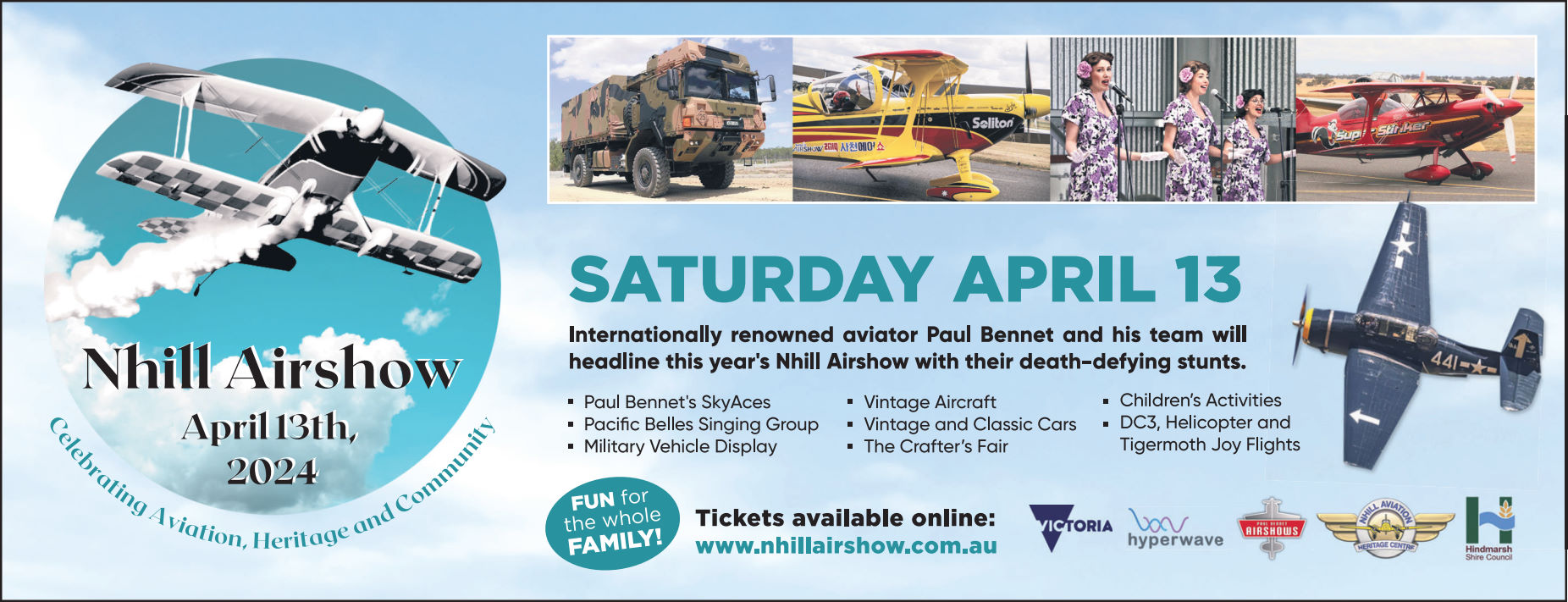The Tarranyurk Public Hall was one of many small country public halls that were built across the Wimmera early last century that was once the hub of a vibrant community, and while no longer serving its original purpose, this building is still fulfilling an important role at its one-hundredth birthday earlier this week.
Officially opened on 10 May 1922, the Tarranyurk Hall spent fifty years hosting many different local functions, but once the community no longer required it, it was repurposed and has now spent the second half of its life as a display space in the Wimmera Mallee Pioneer’s Museum in Jeparit.
Immediately after World War One, several prominent Tarranyurk district residents began discussing the idea of erecting a public hall, as the community had previously relied on the generosity of local farmers to make their barns available for large public gatherings.
This committee, led by Mr William Harrop as President and Mr Wally Volkmann as Secretary, quietly promoted local functions rather than directly asking for donations to raise funds to provide a public venue for the residents of the Tarranyurk district.
An event held specifically to raise money for the Hall was Tarranyurk’s first sports carnival held in September 1920 on the local football ground in Mr Lehmann’s paddock.
These carnivals were very popular at this time, with many hosted across the Wimmera, and they involved a program of foot races and novelty events. An entry fee was charged to participate in each event, and monetary prizes were offered to the winners, with several notable exceptions, such as for the Catching Greasy Pig competition in which the prize was the pig, and the Old Buffers’ Race where a bag of flour was on offer for the winner.1920 Inaugural Tarranyurk Sports
Proceeds in aid of Tarranyurk Hall Building Fund
Program- Sheffield Handicap
- Novice Handicap
- Hurdle Race
- Stepping a Distance
- Kicking a Football a Distance
- Hich Jump Handicap
- Throwing Ball at Wicket
- Hop, Step and Jump (Handicap)
- Tilting the Ring (on Horseback - Prize - Bridle)
- Youths’ Race (17 years and under)
- Catching Greasy Pig (Prize - the Pig)
- Old Buffers’ Race (Prize - a Bag of Flour)
- Young Ladies Race
- Boys’ Handicap Race (14 years or under)
- Girls’ Handicap Race (14 years or under)
- Tug-of-War (6 men aside)
- Sack Race
- Obstacle Race
- Nail Driving for Ladies
- Weight Guessing of Sheep (Prize - the Sheep)
- Cake Weight Guessing (Prize - the Cake)
- Ladies Stepping a Distance
- Married Ladies Race
- Jeparit Leader, 18 August 1920 While many of the events had a lighthearted focus, the feature event was a more serious Sheffield handicap footrace over 130 yards run under the rules set by the Victorian Athletics League. Depending upon entries, a series of heats culminated in a final, with some prestige associated with winning.
At this first running of the Tarranyurk Sheffield Handicap, J Parker won running off a handicap of 7 yards, and Lawrence Binns won the Novice Handicap off 9 yards.
The day concluded with a ball held in Mr Lehmann’s barn that was reported as uncomfortably crowded and perhaps the largest ball ever held in Tarranyurk, emphasising the need for a public facility for these functions.
This whole event raised over £100 and was considered such a success that another was held the following year, adding a further £100 to the Hall fund.
By early 1921 enough money had been raised that a contract was signed to construct a building, although due to some delays, it took until May 1922 to complete and be ready for an official opening. The decision was made to spend the available money on a larger unlined building instead of spending too much on details, leaving that for future generations to add their own touches.
The committee purchased the block of land on the south-west corner of the road intersection in the town for £30, on which was built a hall of corrugated iron with a 60 feet by 25 feet planed jarrah floor, perfect for dancing. This was the biggest floor space of any hall in the Jeparit district at the time. The total cost of this stage of the project was £574, including the building and the land, plus another £90 was spent on a piano.
By the official opening, nearly half of this debt had already been paid, and it was hoped that the remainder would be cleared within the next two or three years if the same level of support for the project continued.
Dimboola Shire Councillor Henry Hamdorf carried out the official opening in front of a large crowd that filled the new venue for an evening of entertainment which included a concert with two vocal numbers by local girl Miss Duclie Milkins, a recital by school teacher Mr F Morter, several humorous items by Messers Burn and Desmond, and several musical items by the Jeparit Orchestra.
Cr Hamdorf’s opening speech included a plea for the locals not to be complacent and continue to contribute to clearing the debt as soon as possible, unlike the Jeparit Mechanic’s Hall committee that took nearly thirty years to pay off their investment.
Following the formalities, the hall was cleared for dancing, where a very large number of gay steppers spent an enjoyable time dancing to the music of the Jeparit Orchestra, which included a piano, violin, and cornet, under the watchful eyes of Masters of Ceremonies Vic Gaulke and Thomas Harrop.
A popular supper was served during the interval, which lived up to the standard for which the district ladies were well known. Many will live to remember this gala night at Tarranyurk, and the hope was expressed before departing that evening that many more functions of such social success would be held in the near future. Due to their ongoing success, the sports carnivals continued to be held until 1924, raising considerable income for the Hall committee. The Sports Club was revived again ten years later, and at least two more carnivals were held, but it was not reported if the profits were still being directed to the Hall committee.
For the next fifty years, the Tarranyurk Public Hall regularly hosted dances and card nights, football and tennis premiership balls, and school concerts, and many locals celebrated significant life events such as engagements, weddings, and major birthdays within its walls.
In 1932, the recently re-formed Tarranyurk Tennis Club was granted permission to construct two new courts within the hall’s grounds, and sometime later, a supper room was added to the west side of the main building.
By the late 1960s, with no local sporting clubs remaining to use the building and residents having the means to travel further for entertainment, it saw less use until it was no longer a useful asset for the community.
In 1973, the Wimmera Mallee Pioneers Museum acquired it and transported it up the road to their site at Jeparit, where it became a significant addition to their local building collection.
To mark this occasion, in the best traditions of the hall’s heyday, it hosted one last night of dancing and cards before it began the next phase of its life.
The organising committee took the opportunity to make this a ‘back-to’, going to great lengths to contact many former residents of the area to invite them to come and relive memories and reminisce about the last half a century in the ’Yurkie’ community.
More than 280 people, many wearing appropriate period clothing, crowded into the hall to enjoy the evening with old friends.
Shirley Gordon (nee Milkins) of Darwin was the person who had travelled the furthest to attend, whilst many others travelled from Melbourne and Adelaide, and many places in between, along with a good attendance of current-day locals.
Long time resident, and veteran of both World Wars, Lawrence Binns, was the oldest person present, with other older identities present including Vic Gaulke, who was Master of Ceremonies at the opening of the Hall fifty-one years earlier.
Entertainment for the evening included the presentation of a brief history of the building by the last president of the committee, Mr Alex Spear, a card tournament, and dancing to the music of an orchestra consisting of three-button accordions, a violin and banjo, and the Master of Ceremonies was Ern Gaulke, the last secretary of the Hall committee.
Due to the large number of people attending, the country-style supper had to be served on tables outside in front of the hall, as there was not enough room inside.
Following the final dance, Auld Lang Syne was sung, which brought to an end an enjoyable evening and just over fifty years of this style of community entertainment in the Tarranyurk district.
One hundred years after becoming the social focus of a small country community, the Tarranyurk Public Hall now plays an important role in housing an eclectic collection of items that form a small part of the museum’s collection, amongst which are the Tarranyurk School 3000 sign that previously adorned the front of the local school building and the large trophy that was presented to the Tarranyurk Football Club after they won three consecutive premierships between 1938 and 1940.
|






